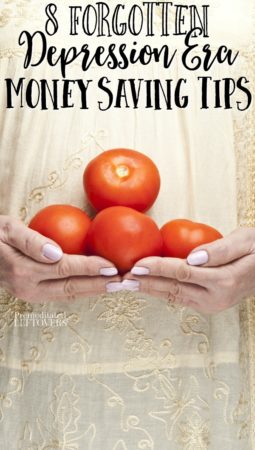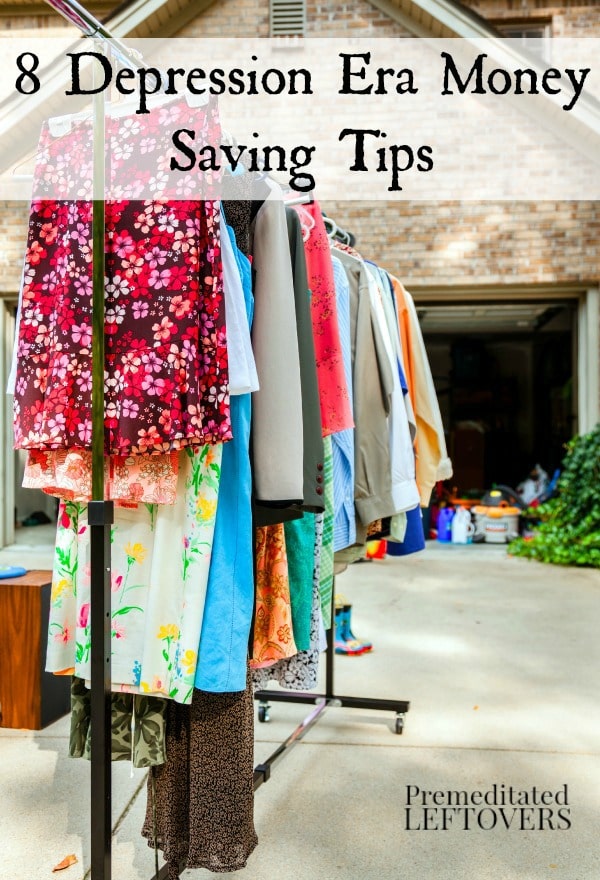You can start using these Great Depression Era money-saving tips today!

When most people think of the height of frugal living, the depression era is often the #1 time they think about. It was a time when most people didn’t waste anything, used their creativity and ingenuity to solve problems and managed to make it through, even when times were extremely tough and budgets simply did not exist because there was nothing to spend.
When I think of the depression era, I am reminded of how much we waste now and how they managed to use everything without even a complaint. It just was the way things were and everyone contributed to the household. If you would like to employ some good, old-fashioned money-saving tips that they used in the depression era to save your household some money, here are 10 forgotten Depression Era money-saving tips to start using now.
8 Depression Era Money Saving Tips
Learn the art of haggling.
People in the depression era didn’t just take the first quoted price for something. They knew how to trade, haggle, and make deals. We may not haggle these days outside of the car lot, but that doesn’t mean we can’t save money on the things we want. I keep notes of the items I need and then watch for sales on them. But it never hurts to ask when a store’s next sale will be.
Trading is starting to come back. More stores are offering to give you credit on used electronics when you are upgrading. Some stores buy back CDs, Vinyl Records, Books, or DVDs. Others buy back gaming equipment or phones. When you need a new item, see if you can, at least partially, fund it with something you no longer use.
While most of us are not comfortable haggling, you can use the internet to find the best price on an item. If you can offer proof of that price, some stores have a price matching guarantee.
Don’t shop for fun.
Recreational shopping wasn’t really an option for most people during the Great Depression. It is amazing how much money we waste when we shop because we are bored. Make it a habit to not do so. Bored? Pick up a deck of cards, work on a puzzle, call a friend, read a book, work in the garden, or choose another no-cost hobby to entertain yourself.
Buy used.
Many families bought things that their neighbors no longer needed in order to save money. This should be a priority for you if you are looking to save money especially when it comes to things like kids’ clothing, seasonal items, and even household basics. Check out your local thrift stores, Craigslist, eBay, or even Facebook Marketplace.
Shop locally.
You may be surprised by how cheap things are when you buy from local stores. Many people shop at big box stores because we have been trained as consumers to think they are cheaper. The truth is, they are often not cheaper and you can get great deals from local markets. This is usually true of farmers’ markets because you are shopping in-season as well.
Even if the price is higher, you may save money because you do not have to pay shipping costs. Have you ever had your online cart at $23 when the business reminds you that if you spend $35, you will get free shipping, so you buy a $13 item that you don’t really need to save $4.99 on shipping? Yeah, they trick you into spending more because you hate paying shipping costs.
Reduce the use of household products.
Most of us use too much dish soap, shampoo, and lotion as well as many other products. Reduce the amount you use and you may be surprised that it’s enough. This will save you from having to replenish personal care products, beauty products, and cleaning supplies as often.
If you read the back of the bottles, they will often say, “Use a pea-size amount”. Try just following the guidelines on the back of the bottle. Carefully look at the lines on the laundry soap measuring cup. Most of the time, you only need the amount at the lowest line, but we are in the habit of filling the whole cup using 3 – 4 times as much as we need.
My kids always use too much soap when watching their hands, so I fill the soap dispenser halfway with soap, then fill it the rest of the way with water. I put the lid on and then shake to mix the water into the soap.
Stretch your meat or skip it in meals.
Often, families did not have the money to have meat with most meals during the great depression. They stretched what meat they did have with beans and lentils. If you don’t feel you can go meat-free, try ubstituting beans or lentils for half the ground meat in your recipes. You will save money and consume much-needed fiber.
How to Build a Depression Era Pantry
Filling Depression Era Breakfast Recipes
Frugal and Flavorful Depression Era Recipes
Depression Era Tips to Stretch Your Food Budget
Don’t buy disposable things.
Disposable products simply didn’t exist during the Great Depression. Now, we live in a disposable era. But it is easy and much more frugal to trade paper towels for rags and sandwich baggies for reusable containers. Look at the disposable products you are buying and find a reusable resource in your home.
Try some holistic health.
In our grandparent’s time, it was expensive to see a doctor just like it is now, and it wasn’t unheard of to try weird concoctions for healing various ailments. Don’t use any of the disproved methods of former days! However, it may be smart to try things like essential oils for minor ailments before reaching for that medication or going to your doctor’s office for minor things like congestion from a cold.
More Old-Fashioned Money Saving Tips
More Money-Saving Tips from the Depression Era
60 Frugal Hacks from the Great Depression Era
Frugal Depression Era Gardening Tips




marcelina pelkey says
My Nana made fresh tortillas and beans every day and raised her own chicken for meat and eggs…I make my own tortillas and fresh beans and use the tortillas instead of bread.I don’t have chickens but I do buy 1 chicken and make 3 meals for my family of 4.
Sarah says
Gardening and hunting are also up there on ways to save. And I say this as a person who has the epitome of “brown thumb” and couldn’t hit the broad side of a barn if my life depended on it. LOL. But both my parents fed us for years on wild game and mostly home grown veggies. Things like carrots and potatoes can keep for months in a cellar. We did grocery shop for things we didn’t have access to where we lived, like many fruits. But we grew raspberries, strawberries, potatoes, corn, carrots, green beans, peas, parsnips, tomatoes, various squashes, watermelon, pumpkins, cucumbers, zucchini, rhubarb. And the last few years of their lives, they grew some AMAZING garlic.
Meanwhile, I can’t even manage to keep a 12 foot long, 2 foot wide patch of lawn alive 😂